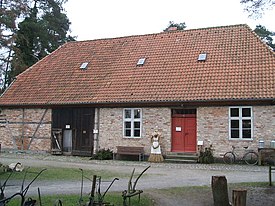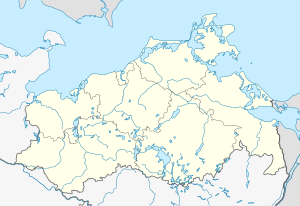Stralsund Zoo
| Stralsund Zoo | ||
|---|---|---|
| motto | From the farm to the jungle | |
| place | Barther Straße 57a 18437 Stralsund (visitor entrance : Grünhufer Bogen 2 18437 Stralsund) |
|
| surface | 16 hectares | |
| opening | 1959 | |
| Animal species | 151 species (Jan. 1, 2015) | |
| Individuals | 975 animals (Jan. 1, 2015) | |
| Visitor numbers | 114,979 (2014) | |
| organization | ||
| management | Christoph Langner | |
| Sponsorship | City of Stralsund | |
| Funding organizations | Zoofreunde Stralsund eV | |
| Member of | VdZ , State Zoo Association MV | |
|
Farmhouse in Stralsund Zoo |
||
| http://zoo.stralsund.de/ | ||
|
|
||
Coordinates: 54 ° 19 '1.4 " N , 13 ° 3' 0.9" E
The Stralsund Zoo (also Stralsund Tierpark ) is an institution for the care of native animal species in the Hanseatic city of Stralsund . The area by the city forest covers around 16 hectares . The zoo was recognized as a " zoological garden " in 2005 , but continued to use the name "zoo". In addition to numerous native animals, many animals from other continents are also shown. Keeping a large group of white donkeys is very rare in Germany .
There is also an original arable house that has been moved here ; In addition, the Mahnkesche Mühle (former location: Mahnkesche Wiese ) was rebuilt here.
target
The Stralsund Zoo has set itself the goal of preserving and breeding rare domestic breeds of domestic animals, some of which are threatened with extinction. The white donkey , the rough-wooly Pomeranian sheep , the Girgentana goat , the East Prussian skudde or the Caucasian dwarf zebu are among these animals.
history
Deer and deer enclosure Küterbastion
1928 Stralsund teacher Frido Schmidt founded the "Tiergarten club Stralsund" which in 1928 on the Küterbastion before Kütertor an enclosure for deer and deer docked. The animals could be viewed free of charge, the association financed the operation of the enclosure through donations. Due to the difficult supply situation during World War II, the enclosure had to be closed on March 8, 1944.
Fasanerie Küterbastion
After the Second World War, a school garden was initially laid out on the site. In the adjacent Knieperteich, traditional swan breeding, documented as early as 1630, was resumed in 1956 .
The area on the Küterbastion was far too small for a zoo, so the gardening authority of the city of Stralsund set up a pheasantry there in 1959 , which opened for the 3rd Baltic Sea Week with four aviaries for ornamental poultry and an enclosure with rhesus monkeys . The pheasantry was completed in 1960 and a terrarium was added in 1962 . The facility was renovated in 1989, but had to be closed in 1993 after 34 years of operation, as it had repeatedly become the target of destruction and theft within a short period of time. Today there is a children's playground at this point.
Zoo in the city forest
In the urban forest of the city also in 1959 the first open-air enclosure for were wild created, which formed the foundation of today's zoos. The goal was a game reserve without a fence; however, this was given up in 1964 and the zoo was fenced in. In 1960 additional facilities were created for red deer and aviaries for red fox and wolf , and in 1961 facilities for ponies and donkeys , nutrias , raccoons , raccoon dogs and two brown bears were added. In 1964 a breeding success could be reported for the first time; Caucasian dwarf zebus were exchanged for the donkeys raised .
In the next few years, under the direction of Hartmut Olejnik, following a fundamental decision in 1965 , the zoo was systematically expanded into a home zoo with the help of many voluntary helpers and help from Stralsund businesses and institutions. Entry was free from 1965 to 1969, after which an entrance fee had to be paid into a "trust fund".
Numerous new buildings were erected up to the 10th zoo festival, which was regularly celebrated: 1962 a bird of prey aviary, 1964 a farm building, 1966 the sheep enclosure, 1967 the cattle enclosure, 1968 a supply kiosk. In 1969 a memorial stone was inaugurated.
In the next ten years the animal population and the reputation of the Stralsund facility grew within the zoos of the German Democratic Republic , but also internationally. This is proven again in 1970 by the first offspring among bears. An enclosure for pumas and the open-air theater were built in 1970. In 1971 the zoo became an independent city-sponsored facility. This year, for the first time, over 100,000 visitors were counted: 110,810 people also looked at the horse stables created in 1971, the rabbit enclosure and the water fowl pond .
In 1973 the construction of the monkey house began, which was completed in 1974. Since 1974, visitors have also had to pay their entrance fee at a ticket office.
A multi-purpose hall was completed in 1978 and a social building in 1981. In 1982 the area of the zoo was greatly expanded. Many of the facilities have been renovated and expanded. In the 1980s, the zoo was shown on GDR television in a zoo TV series. In 1984 an aviary was built for the Stralsund high flyers , and in 1986 the parrot house. In 1991 the entrance was moved from Barther Strasse to Grünhufer Bogen .
In 2005 a new, larger house with an outdoor enclosure was opened for the monkeys, for which many people from Stralsund had donated.
In 2006 a new, spacious enclosure was opened for the brown bear Jule ; work is currently being carried out on an enlarged leopard enclosure.
From 2006 to 2011, the Mahnkesche Mühle was removed from its original location and rebuilt true to the original on the zoo grounds.
With the help of sponsors and animal sponsorships, the operation of the zoo is to be secured and expanded.
Livestock
Fallow deer , pot-bellied pigs , Siamese cats , silver fox and a male brown bear were acquired in 1962.
The number of animals was extended by Racka sheep , gold jackals and dingoes (1965), sheep , lion (loan) and bison (1966), cattle , Watussis , yaks , water buffalo , steppe cattle , moorland and Hutaffen (1967), Siberian sled dogs , blue foxes , and monkeys (1968) and various sheep breeds (Karakul, four-horned, Mongolian and maned sheep) (1969).
In 1971 Jämtland goats , coatis and Hungarian wool pigs are purchased. Other acquisitions in the coming years include lions , collar bears and naked dogs (1973). 20th Tierpark hard you could look back on more new purchases: Baribalbären , moose , Indian hanging ear goat , eagle owls (1974), guanaco , lynx , Korsak (1975), Fettsteißschafe , llamas , Bactrian camels , tarpan , Black Panther (1976), aurochs , leopards , Nandu (1977), steppe eagle and snowy owl (1978), gray parrots (1982), Mangalica pigs , tigers check ponies (1983), Goffinikakada , Gelbhaubenkakadu , caracal (1985), Siamese Fireback , Mink (1989), Benttkänguruh , ocelot , white pelican , white donkey , pythons (1990), Black vulture and cynomolgus monkeys (1991), cheetahs , China leopards , golden eagles , rough-legged buzzard , wild cats , Polar Wolf and common marmosets (1992), Bezoarziegen , agoutis and Przewalski's Horse (1993) were the total stock in 1993 to 95 Domestic animal breeds, 158 animal species and over 1,000 individuals are increasing.
In 2005 there were around 800 individuals from 133 species, including 70 breeds of domestic animals. Were added, among others barking . At the end of 2006, 783 animals from 133 species were counted.
In 2008 the two female lions had cubs; the father of the young died soon after of old age. At the beginning of 2009, the zoo's three bison died of malignant catarrhal fever .
Breeding successes
|
|
literature
- Hartmut Olejnik : Stralsund Zoo 1959-1994 , published by Stralsund Zoo in 1994.
Web links
Individual evidence
- ↑ a b c Data sheet on Stralsund Zoo on the homepage of the Association of Zoological Gardens , accessed on December 9, 2015.
- ↑ Page no longer available , search in web archives :, Access 5/2013
- ↑ Page no longer available , search in web archives: "OpenDocument", January 3, 2007, www.stralsund.de












